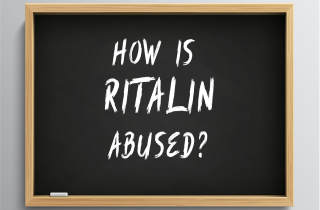Ritalin (methylphenidate) is a central nervous system stimulant drug that has become the primary drug of choice in treating attention deficit hyperactivity disorder (ADD, ADHD) in children. When taken as prescribed, Ritalin can help children and adults feel calm and focused. In fact, it works by activating the motor inhibitory system in the orbital-frontal-limbic part of the brain, helping to inhibit impulsiveness. But what happens when Ritalin is used OTHER THAN PRESCRIBED? We review here. Then, we invite your questions or comments about Ritalin abuse at the end.
Can Ritalin be abused?
Yes, Ritalin can be abused.
Currently, Ritalin (methylphenidate) abuse is monitored by the DEA via the Controlled Substances Act and has been assigned schedule II status, which means the drug has a high potential for abuse and may lead to severe psychological and physical dependence. When methylphenidate is abused, stimulation of D1 dopamine receptors in the brain is thought to be related to the euphoria (the feeling of being high) and can trigger repeated use.
Still, as Ritalin’s main ingredient methylphenidate has shown increases in prescribing frequency, the potential for abuse has increased. Given this increasing number of patients receiving Ritalin and its increased availability, there is an increased potential for this medication to be abused.
How Ritalin is abused?
1. High dosing – Ritalin abuse often entails the use of large doses. However, methylphenidate can be transformed from a therapeutic agent to an abused and addictive substance when this drug is taken in excessive amounts. Further, if you take too much, you may find that Ritalin no longer controls symptoms, or you may feel a need to take large amounts of the medication, and/or you may experience unusual changes in your behavior. At high doses, Ritalin can lead to serious cardiovascular complications, including stroke.
2. Route of administration – Ritalin is also abused when taken intranasally or intravenously. Nasal snorting of Ritalin activates receptor effects similar to those of cocaine. A rapid release of synaptic dopamine occurs, producing subjective effects of an instant “high” and an intensely gratifying euphoria.
3. Use without a prescription – The use of Ritalin by anyone other than the patient to whom it was prescribed is also considered drug abuse. In fact, using Ritalin to get high is a sign of Ritalin addiction. Do not sell, give away, or let anyone else take your medication. Selling or giving away Ritalin may harm others and is against the law.
Ritalin abuse side effects
People who abuse Ritalin risk binge use, psychotic episodes, cardiovascular complications, and severe psychological addiction. Mainly, the clinical picture of stimulant abuse produces a wide array of psychiatric symptoms. The manifestation of the side effects is often quite dramatic, but transient. The main negative side effects of Ritalin abuse can include:
- aggressive behavior
- confusion
- delirium
- disorientation
- depression during withdrawal
- emotional instability
- extreme anger
- hallucinations
- loose association of ideas
- loss of impulse control
- panic states
- paranoia
- toxic psychosis
If you are taking Ritalin as prescribed, these symptoms rarely occur. On the other hand, the extreme consequences of abuse can result in legal repercussions, psychiatric symptoms and disorders, as well as death and homicide. In fact, these need to be discussed seriously. The medical and treatment communities need to be aware of these potential problems, and primary care practitioners need to be aware of the problems associated with Ritalin, recognize the abuse patterns, and take a strong position in educating all those concerned with Ritalin use.
Signs of Ritalin abuse
One main indicator that a loved one has been abusing Ritalin are strong mood swings. A nice “up feeling” is inevitably followed by a “crash”, a feeling of fatigue, depression and decreased alertness. The user soon comes to know that this “crashed out” feeling can be relieved with the “help” of another pill that gets him back up again. Other signs of Ritalin abuse include:
- bizarre, erratic, sometimes violent behavior
- dilation of pupils
- disturbed sleep patterns
- increased heart rate, blood pressure, and body temperature
- loss of appetite
- nausea
Questions about Ritalin abuse
Do you still have questions about how Ritalin is abused? May you think a loved one has a problem. Please leave your questions or comments below. We’ll do our best to respond to you with a personal and prompt reply.









Related Posts